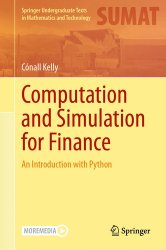Computation and Simulation for Finance: An Introduction with Python
- Добавил: literator
- Дата: 20-07-2024, 07:27
- Комментариев: 0
 Название: Computation and Simulation for Finance: An Introduction with Python
Название: Computation and Simulation for Finance: An Introduction with PythonАвтор: Cónall Kelly
Издательство: Springer
Год: 2024
Страниц: 330
Язык: английский
Формат: pdf (true), epub
Размер: 31.3 MB
This book offers an up-to-date introductory treatment of computational techniques applied to problems in finance, placing issues such as numerical stability, convergence and error analysis in both deterministic and stochastic settings at its core.
The first part provides a welcoming but nonetheless rigorous introduction to the fundamental theory of option pricing, including European, American, and exotic options along with their hedge parameters, and combines a clear treatment of the mathematical framework with practical worked examples in Python. The second part explores the main computational methods for valuing options within the Black-Scholes framework: lattice, Monte Carlo, and finite difference methods. The third and final part covers advanced topics for the simulation of financial processes beyond the standard Black-Scholes setting. Techniques for the analysis and simulation of multidimensional financial data, including copulas, are covered and will be of interest to those studying machine learning for finance. There is also an in-depth treatment of exact and approximate sampling methods for stochastic differential equation models of interest rates and volatilities.
Written for advanced undergraduate and masters-level courses, the book assumes some exposure to core mathematical topics such as linear algebra, ordinary differential equations, multivariate calculus, probability, and statistics at an undergraduate level. While familiarity with Python is not required, readers should be comfortable with basic programming constructs such as variables, loops, and conditional statements.
We choose Python as our language of instruction, reflecting its growing usage among quantitative analysts. Experience with Python is not assumed, though readers should be familiar with basic programming constructs such as variables, loops, and conditional statements. Nonetheless, this is not a Python reference: after a tutorial in Chap. 1 we will introduce functionality as we go. Where possible we make use only of core Python libraries, and we avoid black-box approaches where it is sensible to do so. The result is intended to be an accessible introduction to computational techniques with enough guidance on the programming side to ensure that readers can easily get practical experience.
The book is divided into three parts. Part I (Modelling Assets and Markets) is an introduction to the mathematics of finance and the pricing and hedging of derivative securities in the Black-Scholes framework, as well as a tutorial introducing the reader to Python as a programming language. Part II (Computational Pricing Methods in the Black-Scholes Framework) covers the three main computational methods for pricing options and their associated hedge parameters: binomial trees, Monte Carlo methods, and finite difference methods, and demonstrates their application to the valuation of European, American, and exotic options written on a single underlying asset.
Part III (Simulation Methods Beyond the Black-Scholes Framework) treats a set of more advanced topics and techniques, introducing Python methods for data analysis (providing a point of entry for students interested in machine learning), and modelling with stochastic differential equations. The financial context includes the modelling of several correlated assets, stochastic models of interest rates, and asset models with local or stochastic volatility.
Скачать Computation and Simulation for Finance: An Introduction with Python
[related-news] [/related-news]
Внимание
Уважаемый посетитель, Вы зашли на сайт как незарегистрированный пользователь.
Мы рекомендуем Вам зарегистрироваться либо войти на сайт под своим именем.
Уважаемый посетитель, Вы зашли на сайт как незарегистрированный пользователь.
Мы рекомендуем Вам зарегистрироваться либо войти на сайт под своим именем.
